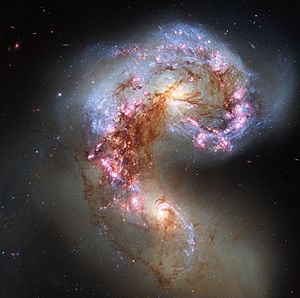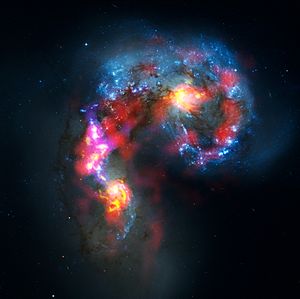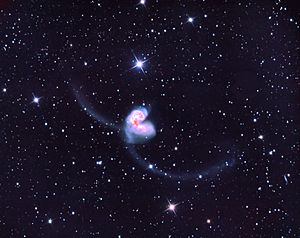Antennae Galaxies facts for kids
Quick facts for kids Antennae Galaxies |
|
|---|---|

Hubble Space Telescope image of NGC 4038 (top) and NGC 4039 (bottom)
|
|
| Observation data (J2000 epoch) | |
| Constellation | Corvus |
| Right ascension | 12h 01m 53.0s / 12h 01m 53.6s |
| Declination | -18° 52′ 10″ / -18° 53′ 11″ |
| Redshift | 1642 ± 12 / 1641 ± 9 km/s |
| Distance | 45 Mly / 65 Mly |
| Type | SB(s)m pec / SA(s)m pec |
| Apparent dimensions (V) | 5.2′ × 3.1′ / 3.1′ × 1.6′ |
| Apparent magnitude (V) | 11.2 / 11.1 |
| Notable features | Interacting galaxies |
| Other designations | |
| Ringtail Galaxy, NGC 4038 / 4039, PGC 37967 / 37969, Arp 244, Caldwell 60/61, UGCA 264/265 |
|
| See also: Galaxy, List of galaxies | |
The Antennae Galaxies (also known as NGC 4038/NGC 4039 or Caldwell 60/Caldwell 61) are two galaxies that are crashing into each other. They are found in the constellation Corvus.
Right now, they are in a "starburst" phase. This means lots of new stars are forming very quickly. This happens because huge clouds of gas and dust are smashing together during the collision. William Herschel first discovered these galaxies in 1785.
Contents
What Are the Antennae Galaxies?
The Antennae Galaxies are part of a group of galaxies called the NGC 4038 group. They are famous because of their unique shape. As the two galaxies collide, long tails of stars, gas, and dust are pulled away. These tails look like the antennae of an insect.
The central parts, or nuclei, of the two galaxies are slowly joining together. Eventually, they will form one giant galaxy. Scientists believe that most galaxies, including our own Milky Way, will go through at least one big collision in their lifetime. Our Milky Way is expected to collide with the Andromeda Galaxy in the future.
Five supernovae (huge star explosions) have been seen in NGC 4038. These include SN 1921A, SN 1974E, SN 2004GT, SN 2007sr, and SN 2013dk.
Recent studies suggest these galaxies are closer to us than once thought. They are about 45 million light-years away, not 65 million.
The Antennae Galaxies also have many young, massive globular clusters. These are groups of thousands of stars packed tightly together. They likely formed from the shockwaves created when the galaxies collided. These shockwaves squeezed large gas clouds, and the densest parts of these clouds became new star clusters.
How the Antennae Galaxies Changed Over Time
The Antennae Galaxies have changed a lot over billions of years.
- 1.2 billion years ago: They were two separate galaxies. NGC 4038 was a barred spiral galaxy (like a spiral galaxy with a bar of stars in the middle), and NGC 4039 was a regular spiral galaxy.
- 900 million years ago: The galaxies started to get closer, looking similar to NGC 2207 and IC 2163.
- 600 million years ago: They passed through each other, looking like the Mice Galaxies.
- 300 million years ago: Stars began to be pulled away from both galaxies, forming the long tails.
- Today: The two long streamers of stars stretch far beyond the original galaxies, giving them their "antennae" shape.
In about 400 million years, the centers of the Antennae Galaxies will crash together. They will become a single core surrounded by stars, gas, and dust. Scientists believe that the Antennae Galaxies will eventually form a single, large elliptical galaxy.
X-ray Discoveries
Scientists used the Chandra X-ray Observatory to study the Antennae Galaxies. They found areas with large amounts of neon (Ne), magnesium (Mg), and silicon (Si). These are called heavy elements.
Heavy elements are very important for planets to form. They are also needed for life as we know it to exist. The clouds in the Antennae Galaxies have 16 times more magnesium and 24 times more silicon than our Sun.
See Also
 In Spanish: Galaxias Antennae para niños
In Spanish: Galaxias Antennae para niños
- Whirlpool Galaxy
- List of largest galaxies



